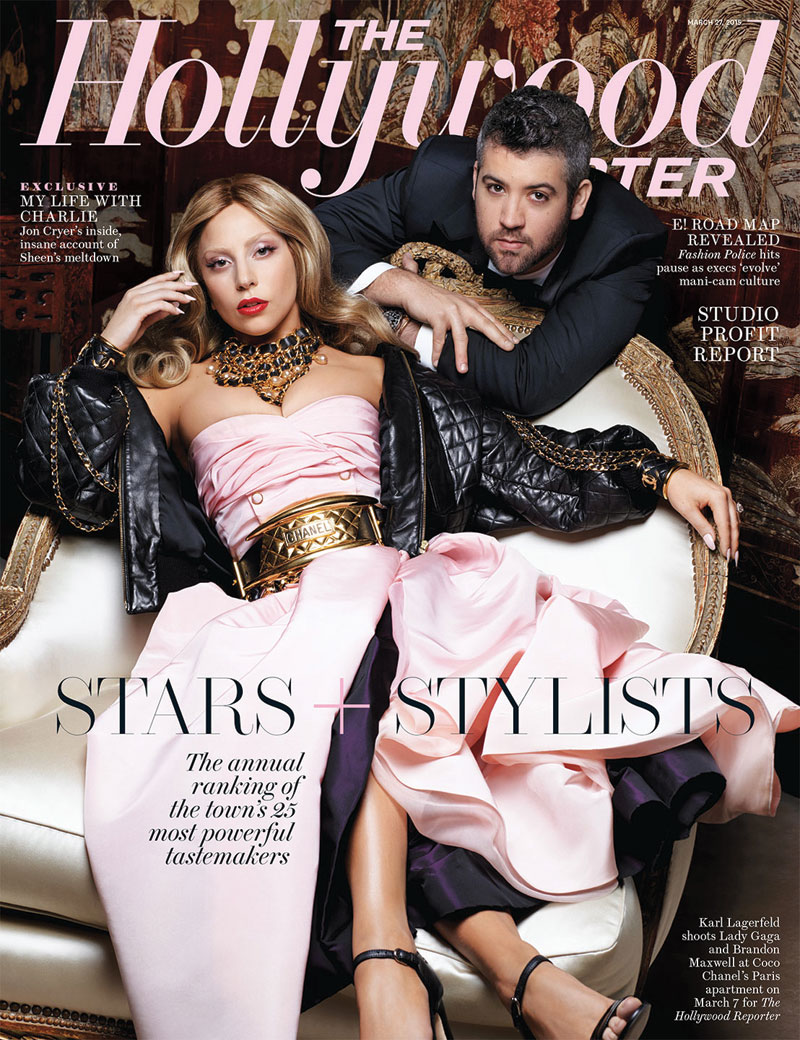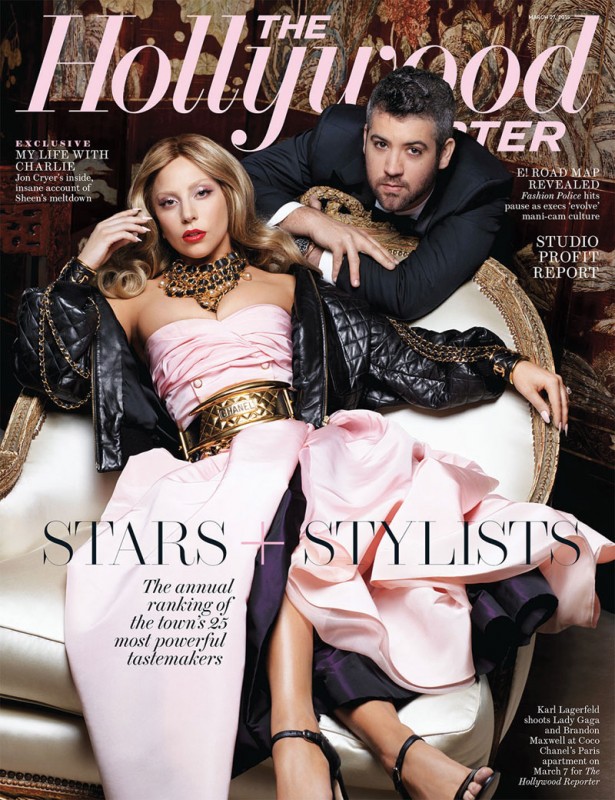- Janice Minn
- Merle Ginsberg
Under the leadership of Janice Min, The Hollywood Reporter has transformed into a high-gloss, heavily reported weekly that is required reading among anyone even remotely interested in the happenings of Tinseltown. The magazine’s annual fashion issue, centered around its Power Stylists list, has emerged as one of its marquee moments, with the 2015 edition featuring an interview with Riccardo Tisci and a cover of Lady Gaga photographed by Karl Lagerfeld. Chief Creative Officer Janice Min and senior style writer Merle Ginsberg explain its ascent.
How does your Power Stylists list come together?
Merle Ginsberg: First of all, it was Janice’s idea—it’s very much in the tradition of The Hollywood Reporter to do power lists, and we do it for writers, directors, actors. So she said, “Why don’t we do a stylists list? They are, essentially, Hollywood fashion.” And my first response was, “We can’t do that! It’s politically incorrect!” But she looked at me in a very Janice way and said, “Why not?” The criteria comes down to a number of things. It all starts with the way actresses dress on the red carpet. We start with a look, and we work backward. Carol [McColgin, THR style editor and cover shoot stylist], Janice, and I sit down and look at many, many pictures, then we call all the agencies to fact-check, because these actresses jump around [among stylists]. Then we just talk and talk and talk, but it really goes down to the look and the power of it. The status of the actress plays a part, too.
Petra Flannery, who topped your list this year, dressed Emma Stone in a Lanvin jumpsuit for the Golden Globes. Was that a personal favorite?
Janice Min: Every editor will have their own individual opinions about whether a look worked or not, but sometimes the tiebreakers come down to the impact it makes in fashion—how it was received. All these women are wearing these dresses to have maximum impact—that’s the competition, and recognition from the fashion press is how you win the game.
Do stylists or actresses campaign to be in this package?
Janice: Completely! There is an extensive campaign that goes on for positioning on this list. The worst thing of all would be to not be on the list. The top choices are usually fairly logical, and then there is definitely jockeying for position.
Merle: Starting the week before, I’ll have a lot of stylists’ agents calling me, saying, “Just tell me the number.”
Janice: The anxiety runs pretty high out here.
Janice, how have you seen the celebrification of stylists evolve over your tenure at The Hollywood Reporter?
Janice: One of the main impetuses for doing this was the Rachel Zoe factor. The stylist names out here are on par with the designer names, because they have the power to transform, and they have access to looks that can turn a regular actress into someone extraordinary. [Stylists] are sort of the Henry Higginses of Hollywood, in that they can completely alter the course of an actress’s career toward the positive. That is as important, if not more important, than anything a studio executive, agent, or manager can do. They’re the power brokers between talent and designers, and they get to decide who wears what, and when. To be a gatekeeper in that regard means everything to the design community.
Do you think men are paying a lot more attention to their looks these days?
Janice: For the first time, we shot a man in this issue—Channing Tatum with his stylist. There have been times in previous years when we’ve tried to book men, and even though they’re close with their stylists, there was a squeamishness, an embarrassment. That is no longer. There’s honesty about, “I do not fall out of bed and onto the Oscars red carpet looking like this.” There is a team of people to make it happen.
Merle: They used to deny it!
Janice: And now it’s part of the conversation.
How did Lady Gaga end up on the cover?
Janice: It was crazy. Like so many things at The Hollywood Reporter, it magically came together at the last minute. Brandon Maxwell, her stylist, was on the list, and one of the ideas was to shoot him with Gaga as a potential cover. They [Brandon’s team] upped the ante—what if it was shot by Karl Lagerfeld in Paris? We said, Okay! And within 24 hours, Carol was on a plane, then sitting there in Coco Chanel’s old apartment, making the shoot happen.
Did you get any feedback about what Karl was like on set as a photographer?
Janice: Sure. He was very professional, very fast. Gaga and Brandon were very deferential to him. He, of course, kept the gloves on, and did exactly what he wanted. That was no surprise. He’s an art director, photographer, and designer all in one.
Merle, you went to Paris to interview Riccardo Tisci for the issue. What was your experience like?
Merle: I had been trying to get that interview for about four years. I had gone to Paris before and met with Youssef Marquis, a lovely guy who is [Tisci’s] head of press, and he loves The Hollywood Reporter, and he also, like many designers in Europe, used the stylists list to figure out how to negotiate with a lot of Hollywood people. So every year, he’d go, “We’re getting closer. We’re getting closer.” And this was the right year for Riccardo, because he’d had so many major red carpet moments—Julianne Moore, Jessica Chastain, the whole Kim and Kanye thing. I’m rarely nervous interviewing anyone, but I was nervous because I didn’t know anything about Riccardo, although I knew all his work. He was very chill, very warm, very pleasant, very low-key, and surprisingly modest. The interview took place in Hubert de Givenchy’s couture studio, where he dressed Audrey Hepburn. I was incredibly overwhelmed by that. Riccardo couldn’t understand why that freaked me out.
Janice, who is your competition, and how do you feel like it’s evolved?
Janice: I feel like we compete with all media, and that’s a good and bad thing—a mostly good thing about the digital universe, and social media in particular. There is no such thing, to me, as a trade anymore, and any good story travels fast and wide. Our hugest stories could be about topics that in a formerly all-print universe would not have had a life. We’re competing for people’s attention in all ways, whether we’re competing with television, film, their iPhone, Facebook, Instagram—people here will probably tell you that one of the things I’m most obsessed over are headlines.
Merle: She’s the queen of headlines!
Janice: Headlines, and every story having a hook or a point that will draw people in. The art of reading or paying attention to something is totally unconscious. The second you have someone saying, “Ugh, I have to read The Hollywood Reporter,” then you’re sort of dead.
Do you miss New York?
Janice: I don’t miss the weather! I’d like to use my legs again at some point and walk to a restaurant. I miss walking, I miss my friends, but I don’t miss seasons at all. When you’re in New York, you take for granted how casual socializing is. You can see people you know everywhere. “Want to get a drink? What are you doing tomorrow night? Want to have breakfast?” L.A. is vast and wide. No one wants to go out after 5:30. The early bird hour is dinnertime in Los Angeles, which is fine—I have three kids now, and that’s sort of how I live my life regardless.
What’s your lifestyle like in L.A.?
Janice: I work all the time. The good and bad thing about my iPhone is that you have freedom and the ultimate handcuffs.
Merle: I get e-mails from Janice at 2 a.m…
Janice: No you don’t! [Laughs] Okay, yes.
Have you taken up any L.A. pastimes, like surfing or hiking Runyon Canyon?
Janice: There are L.A. clichés that have come into my life. I drive a Tesla, I eat kale every single day, we have a Vitamix at home, where ingredients could include chia seeds and sweet potatoes and other superfoods. I definitely work out more than I would have in New York. But other than that, I don’t have a crystal healer.
How have your relationships with talent publicists changed since you moved to The Hollywood Reporter?
Janice: Anyone who books anything knows that nothing’s easy. We don’t cave on anything. Reporting on a celebrity’s breakups at Us Weekly versus reporting on large, impactful business news about movies bombing, executive changes—people here understand the business of numbers, and those stories have been easier to do. The Hollywood Reporter has a certain hometown advantage of feeling like Hollywood’s high school newspaper that looks really good and reads really well. Our digital presence is a huge, constantly news-breaking machine, but there is a lovely old-school publishing moment on Wednesday morning when our print edition is delivered all around Los Angeles. Studio chiefs, Steven Spielberg, television executives—they all stop to see who’s in it, what they should wear, where they should be going…it becomes a nice little one-stop shop for Hollywood.
Do you get more irate phone calls now than when you were at Us Weekly?
Janice: There are always irate phone calls. You can never escape them. That’s the nature of being in media!
What makes for a successful editor in chief in 2015?
Janice: A healthy sense of competition and a willingness to evolve. I also believe that in an age of overwhelming information, there is a rush to premium content that will be very valuable to a brand. When everyone has the same information, the links that mean the most for me are from the brands I’ve always known and loved. A powerful brand association is what helps you rise above the pack. There is audience in that, and obviously advertiser draw.
Are you still interested in celebrities’ personal lives, if on a recreational level?
Janice: I can’t say I was ever interested in that at Us Weekly! [Laughs] That was the funny thing about working there—I never watched The Bachelor or the Kardashians. I felt like I had knowledge and touch for understanding what the stories were that people cared about.
What are some of your goals for THR in the next five years?
Janice: [Laughs] In the next five years, or in the next five minutes?




